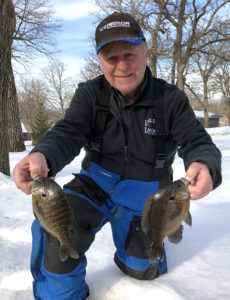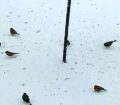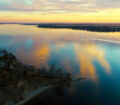By Steve Weisman

(Photo by Darial Weisman) The author with a pair of 9-inch bluegills taken from the North Bay on West Okoboji.
What a strange ice fishing season this one has been so far. We got some ice, then we got warm weather, then we got two inches of rain…and all of that happened in December! So, it’s been quite a roller coaster, and it wasn’t until early January that we began to see ATVs on the ice.
Early on, I was on West Okoboji’s Emerson Bay right out in front of the boat ramp in 8-10 feet of water. Ice came there first, and by mid-December we had a good 6-8 inches of ice. The water was clear enough that you could sight fish, so that’s where I stayed for a couple of weeks.
You know how it is. You find a spot with fish and if you are lucky you don’t get a lot of people fishing in the area. With such thin and clear ice, a lot of people would have spooked the fish away. What I found most strange is the lack of weeds. Nope, no weeds at all. Not even on the bottom. Have no idea why, if the late fall winds destroyed them or what, but the bluegills were just wandering around.
Enjoying the sight fishing game
I truly believe that sight fishing on West Okoboji is the greatest “video game” of all time! All you have to do is use the darkness of your shelter to enable you to see everything below-the bottom, the weeds and the fish as they move through.
Now, since these fish are sight biters, the lure and presentation must be one that will draw them in to the area and eventually trigger a bite. The baits need to be small and the line light, most likely 1-2 pound test. Tungsten jigs like the #14 Clam Drop jig or the next size larger the Clam Dingle Drop both have small profiles, but since they are tungsten, they get down quicker than traditional jigs and their weight helps keep the line taut. However, the tungsten jigs fish light and respond to the jiggle you are trying to perform. I tip the jig with either a wax worm, a couple of silver wigglers or a piece of Maki plastic that makes a tail off the end of the hook.
It is important as you move the jig to not allow it to spin. If it does, very few bluegills will come in and even look at, let alone bite a spinning lure. I do know if a bluegill comes in sight, what you have been doing has tweaked their interest. So, keep moving the jig the same way no matter how long it takes for the bluegill to determine if it wants to bite or move on. If the presentation doesn’t stay the same, most often the bluegill just moves on.
On one trip, I specifically remember one big bluegill, a 9 incher that took a lot of coaxing before biting. I was just quivering the jig, when the bluegill came in from the right. It slowly swam toward the bait and about six inches away, it stopped.
As I continued to quiver the jig, the bluegill moved an inch closer, then an inch back, then forward, then back, then forward, then back…over and over. Finally, the bluegill was nose to jig, and it just stopped right there.
I took a chance and just stopped the quiver and held the jig in place. The bluegill just sat there and stared and stared and stared…and then opened its mouth and sucked the jig in! I won that battle, but there were others that just didn’t commit. Others would bite the side of the jig…well, you can’t catch a fish if you can’t put the point of the hook into the fish’s lip.
Also, you have to anticipate the hookset. Don’t wait until the bait is inhaled. Set the hook as the jig is being sucked in. Sometimes, though, they will bite the tip of the bait and then hold it in their mouth. Don’t set the hook…it’ll just come right out. Wait for the bluegill to move the bait so the hook is in…then set the hook! After a few of these types of bites, you will know when to set the hook.
Moving to the North Bay
It took much longer for the North Bay out from Triboji Boat Ramp to get solid enough to even support foot traffic. The crazy part is this entire end of the lake is smooth as can be: an ice skater’s dream!
Even though water clarity is ok, the normal depths have been the 12-20 feet of water. As a result, the sight bite is no longer in play. It now becomes time for the locators/cameras. The sight fishing strategies still are in place, however. These fish are still sight biters first. The plan now has been to remember how the fish bit in the shallows and translate that to when I am looking at my FL-28 with the fish in 20 feet of water.
Each time I drop my lure down, I make sure it is not spinning. I carefully let the bait down, making sure that the line does not twist. I know for the most part that the lure is not spinning.
Once down, I find the jig on the flasher and put it anywhere from a few inches to a couple of feet off the bottom. Then I watch for lines moving toward my jig. At a distance, it might be green, then yellow and eventually hot red. All the while this is happening, I keep using the same cadence that I used when the fish showed up on the screen.
If I know the fish is hot, right at the jig, I might jiggle it up a little to try to entice the bite. If it follows and just sits, I might do that again. However, if it just follows, I will slow the cadence down to just a quiver and watch for my spring bobber to move. Sometimes, the bobber just dips a 1/16th of an inch, maybe it comes up slightly…all signs to give a hookset and see what happens.
I do know that there is also a good bite going on Big Spirit for perch, crappies, bluegills and walleyes. My only problem? Too many places to go and not enough time. When I can catch 8-9 inch gills consistently where I am at, it’s tough for me to move to another lake.














